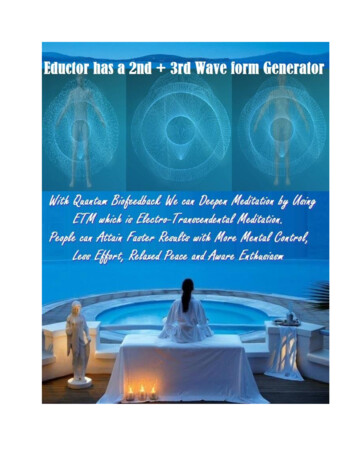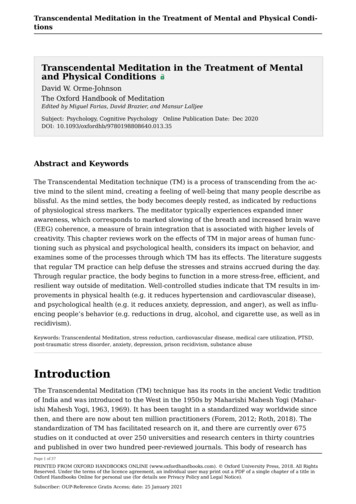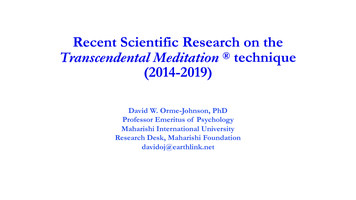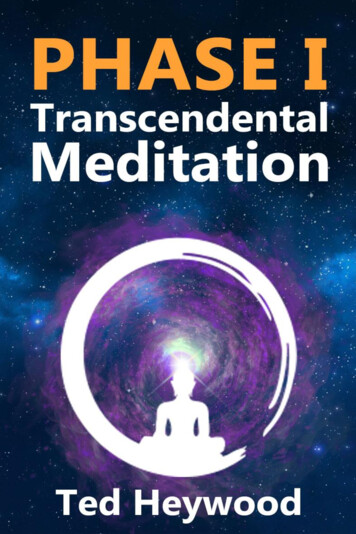
Transcription
Transcendental Meditation Scientifically Proven ToPrevent DiseaseJosh Richardson, Prevent DiseaseWaking TimesMore than 350 peer-reviewed research studies on the Transcendental Meditation (TM) technique havebeen published in over 160 scientific journals. It increases cardiovascular quality, lowers blood pressure,decreases anxiety and among quantum physicists is considered the fourth state of consciousness inwhich the entire brain is engaged.Published research has demonstrated that the practice of regular meditation can increase brain density,boost connections between neurons, decrease symptoms of depression and anxiety, provide clarity ofthought, and increase positive mood endorphins. Other published studies have shown meditation canimprove physical functioning, decrease chronic disease risks, and enhance overall quality of life.In a 2008 study published in the journal PloS One, researchers found that when meditators heard thesounds of people suffering, they had stronger activation levels in their temporal parietal junctures, a partof the brain tied to empathy, than people who did not meditate.This is a small segment of actor/comedian Russell Brand’s interview with renowned quantum physicist Dr.John Hagelin at the David Lynch Foundation’s 3rd annual Change Begins Within gala in Los Angeles.They discuss the science behind the Transcendental Meditation technique, the Unified Field.Most of scientific studies on TM were conducted at many US and international universities and researchcenters, including Harvard Medical School, Stanford Medical School, Yale Medical School, and UCLAMedical School.CardiovascularOn November 2012, a journal of the American Heart Association: 5-year randomized controlled study onpatients with established coronary heart disease reported a 48% reduction in death, heart attack, andstroke in subjects in the TM group compared to controls.HypertensionJune 2013, American Heart Association scientific statement, concluded that the TM technique is the onlymeditation practice that has been shown to lower blood pressure and recommends that TM may beconsidered in clinical practice for the prevention and treatment of hypertension.
AnxietyOctober 2013: Meta-analysis of randomized controlled trials (RCTs) in The Journal of Alternative andComplementary Medicine, found significantly greater effect of TM in reducing trait anxiety than treatmentas-usual and other alternative treatments, including mindfulness-based therapy (MBT) and othermeditation and relaxation practices.According to a report published in the Journal of Alternative and Complementary Medicine, a metaanalysis of TM analyzed 16 trials and 1,295 participants. The conclusion was that TM worked better inreducing severe anxiety than psychotherapy or other relaxation techniques As a bonus, TM alsoproduced lower blood pressure, better sleep, improved family life, less substance abuse and a betteremployment situation.These are just a few of hundreds of studies now showing the effectiveness of TM. It can make your lifemuch more enjoyable and balanced. Many people say this easy-to-practice technique hasa transforming effect — they report major health benefits.It’s a simple, natural technique practiced 20 minutes twice each day while sitting comfortably with theeyes closed.The TM technique is easy to learn and enjoyable to practice, and is not a religion, philosophy, or lifestyle.Over six million people have learned it — people of all ages, cultures, and religions.Unlike other forms of meditation, TM practice involves no concentration, no control of the mind, nocontemplation, no monitoring of thoughts.The TM technique allows your mind to easily settle inward, through quieter levels of thought, until youexperience the most silent and peaceful level of your own awareness — pure consciousness. This isknown as automatic self-transcending.
Brain Behav. May 2012; 2(3): 211–220.PMCID: PMC3381625Effects of cranial electrotherapystimulation on resting statebrain activityJamie D Feusner,1 Sarah Madsen,1 Teena D Moody,1 Cara Bohon,1 Emily Hembacher,2 Susan YBookheimer,3 andAlexander Bystritsky1AbstractCranial electrotherapy stimulation (CES) is a U.S. Food and Drug Administration (FDA)approved treatment for insomnia, depression, and anxiety consisting of pulsed, low-intensitycurrent applied to the earlobes or scalp. Despite empirical evidence of clinical efficacy, itsmechanism of action is largely unknown. The goal was to characterize the acute effects of CESon resting state brain activity. Our primary hypothesis was that CES would result in deactivationin cortical and subcortical regions. Eleven healthy controls were administered CES applied to theearlobes at subsensory thresholds while being scanned with functional magnetic resonanceimaging in the resting state. We tested 0.5- and 100-Hz stimulation, using blocks of 22 sec “on”alternating with 22 sec of baseline (device was “off”). The primary outcome measure wasdifferences in blood oxygen level dependent data associated with the device being on versusbaseline. The secondary outcome measures were the effects of stimulation on connectivity withinthe default mode, sensorimotor, and fronto-parietal networks. Both 0.5- and 100-Hz stimulationresulted in significant deactivation in midline frontal and parietal regions. 100-Hz stimulationwas associated with both increases and decreases in connectivity within the default modenetwork (DMN). Results suggest that CES causes cortical brain deactivation, with a similarpattern for high- and low-frequency stimulation, and alters connectivity in the DMN. Theseeffects may result from interference from high- or low-frequency noise. Small perturbations ofbrain oscillations may therefore have significant effects on normal resting state brain activity.These results provide insight into the mechanism of action of CES, and may assist in the futuredevelopment of optimal parameters for effective treatment.
Keywords: CES, default mode network, fMRI, fronto-parietal network, intrinsic connectivitynetworks, sensorimotor networkIntroductionCranial electrotherapy stimulation (CES) is a noninvasive therapeutic device that appliespulsed, alternating microcurrent ( 1000 μA) transcutaneously to the head via electrodesplaced on the earlobes, mastoid processes, zygomatic arches, or the maxillo-occipitaljunction. The U.S. Food and Drug Administration (FDA) granted approval in 1979 for CESfor the treatment of insomnia, depression, and anxiety, and it is commercially available forpersonal use. Controlled studies provide evidence that CES is effective for anxiety,headaches, fibromyalgia, smoking cessation, drug withdrawal symptoms, and (in some butnot all studies) pain (see Bianco 1994; Klawansky et al. 1995; Kirsch 1996; DeFelice1997; Gilula 2007; O’Connell et al. 2010 for review and meta-analyses). The majority ofcontrolled studies have evaluated the efficacy of CES for treatment of anxiety, although mostwere performed in nonclinical samples (Klawansky et al. 1995;DeFelice 1997). However, ina six-week open-label pilot study of treatment of individuals with generalized anxietydisorder (GAD), CES applied to the earlobes was found to reduce symptoms of GAD, asdemonstrated by a significant mean 40.4% decrease in Hamilton Anxiety Rating Scale scoresat endpoint compared to baseline (Bystritsky et al. 2008).Despite empirical evidence for treatment efficacy for these syndromes, skepticism remains asto how application of microcurrent to the earlobes or scalp could effect these clinicalchanges, likely because of the dearth of studies of its mechanism. As brain stimulationtechniques increasingly hold promise for treatment of neurological and psychiatric disorders(George et al. 2007), better understanding of their mechanisms of action is crucial to furtherimprove their efficacy, develop new technologies, and evaluate their safety.It remains unclear how the electrical current from CES may alter brain activity. Forty-two to46% of the applied CES current enters the brain, with the highest levels of current recordedin the thalamus (Rush and Driscoll 1968; Jarzembski and Sances 1970). One theory suggeststhat the cranial alternating current (AC) stimulation interferes with ongoing brain waveoscillations by introducing cortical noise (Zaghi et al. 2009). In vitro studies of rat brainslices show that high-frequency (50–200 Hz) sinusoidal AC stimulation suppresses activityin cell bodies and axons (Jensen and Durand 2007). Perhaps the most investigated effects todate of CES have come from electroencephalographic (EEG) studies, which have foundrecordings to be altered during and after treatment with CES. Alpha EEG waves were slowedfollowing CES in monkeys, and this change was associated with a reduction in adversereactions to stressful stimuli (Jarzembski 1985). Applying CES at 0.5- and 100-Hz withsimultaneous EEG resulted in a downward shift in mean alpha frequency, with greater effectfor 100-Hz stimulation (Schroeder and Barr 2001). CES also results in a decrease in alphaband median frequency and beta band power fraction (Itil et al. 1972). These changes aresimilar to EEG changes in trained meditators, and may be associated with a relaxed state(Banquet 1973). Although it remains unclear if these alterations in brain wave oscillation
patterns are a cause or effect of improved clinical states, pulsed current may interruptnervous system function.The goal of this study was to determine the immediate effects of CES stimulation on patternsof brain activity in the resting state, and on functional connectivity within intrinsicconnectivity networks. This represents the first investigation of the direct effects of CES onbrain activity using functional neuroimaging simultaneously with cranial stimulation. Wehypothesized that CES would result in deactivation in cortical and subcortical (thalamic)regions, in line with evidence that stimulation interferes with oscillatory brain activity and isassociated with reduction of brain wave frequencies (mean alpha power). We also predictedthat 0.5- versus 100-Hz stimulation would result in different patterns. In addition, wehypothesized that stimulation would alter intrinsic connectivity networks such as the dorsalfronto-parietal network (FPN) (Corbetta and Shulman 2002) (due to evidence ofimprovements in attention with CES [Southworth 1999]), and the sensorimotor network(SMN) (Mantini et al. 2007; Schopf et al. 2010) (due to evidence of clinical efficacy for pain[Tan et al. 2011]). We also predicted it would alter connectivity within the default modenetwork (DMN), as the EEG beta band (which CES 100 Hz may affect [Schroeder and Barr2001]) has been found to correlate with this network (Mantini et al. 2007; Laufs 2008).Go to:Material and MethodsParticipantsThe UCLA Institutional Review Board approved the study protocol. Informed consent wasobtained after the nature and possible consequences of the studies were explained.Eleven healthy right-handed male and female participants aged 18–65 were recruited fromthe community. We administered the Mini International Neuropsychiatric Interview (MINI)(Sheehan et al. 1998) and excluded participants if they met Diagnostic and Statistical Manualof Mental Disorders (DSM-IV) criteria for any Axis I psychiatric disorder including activesubstance abuse, and any participants whom the investigator judged were suicidal. Otherexclusion criteria included any neurological disorders or any medical disorders that couldaffect cerebral metabolism. Participants were excluded if they were taking any psychotropicmedications or any other medications with psychoactive properties. Pregnant orbreastfeeding women and those of childbearing potential who were not practicing a reliableform of contraception were also excluded from the study. Due to constraints of magneticresonance imaging (MRI) scanning, we excluded individuals who weighed greater than 280lbs and those with implanted electronic devices or ferromagnetic materials.CES deviceWe used the Alpha-Stim 100 microcurrent and cranial electrotherapy stimulator for theexperiment, provided by the manufacturer Electromedical Products, International (MineralWells, TX). The AlphaStim 100 provides cranial electrical stimulation by generating
bipolar asymmetric rectangular waves with a frequency of 0.5, 1.5, or 100 Hz, and a currentintensity that can be adjusted continuously to provide between 10 and 600 μA(http://www.alpha-stim.com). We tested 0.5- and 100-Hz pulse frequencies, as these are mostcommonly used in clinical treatment. For the purpose of the experiment, the manufacturermodified the device to automatically cycle between “on” blocks of 22 sec (specifically 10 secon, then 2 sec off, then 10 sec on, due to constraints of the device) and “off” blocks of 22 sec.The device was connected via copper wires to adhesive nonferromagnetic electrodes (1.5-cmdiameter contact area) that were placed on the participants’ right and left earlobes.Pre-MRI sensory threshold CES testingParticipants received individualized subsensory current intensities to minimize the possibilitythat the current could be felt consciously in the scanner. This was done in order to avoidactivation patterns associated with perception of stimulation, and also conforms to the waythe device is used clinically. Testing was done using a forced-choice test outside of thescanner, to ensure that the participants could not guess if the device was on or off, at greaterthan chance level (see Supporting Information for details).CES safety testing in the MR environmentPrior to the experiment, we tested the use of CES in the MRI scanner to ensure safety interms of current, voltage, and temperature, and to verify that it did not produce any artifactsor field inhomogeneities in the MR image (see Supporting Information for details).Behavioral measurementsTo assess for any changes in anxiety related to CES stimulation, participants completed thestate portion of the State-Trait Anxiety Inventory (STAI) (Spielberger et al. 1983) before andafter the fMRI scan.fMRIParticipants were positioned in the scanner and the electrodes were applied to their earlobes.These were connected via long copper wires to the CES device, which the investigatoroperated in the scanner control room. Participants were instructed to: “keep your eyes closedfor the duration of the scan but try not to fall asleep. You do not have to think about anythingin particular.” After the scan, they were informally questioned about whether they could feelthe stimulation during the scan.The experiment consisted of a blocked design in which six “on” blocks of 22 sec alternatedwith six “off” blocks of 22 sec. There was 37.5 sec of baseline prior to the “on” and “off”cycles, and 33.5 sec of baseline following it. The total duration of each experimental run was5 min and 35 sec. Participants completed one run each of the 0.5- and 100-Hz pulsefrequencies, the order of which was counterbalanced between participants. Although theinvestigator in the control room knew when the CES was cycling between “on” and “off”during the scan, the participants did not have any contact with him during each experimental
run, and therefore could not be influenced implicitly or explicitly by the investigator'sknowledge. In this way, a control condition was built into the experiment in which therewere blocks when the CES was off, but the participants did not know when this wasoccurring.We used a 3-Tesla Trio (Siemens) MRI scanner to evaluate BOLD contrast, using T2*weighted echo planar imaging (EPI) gradient-echo pulse sequence (repetition time (TR) 2.5 sec, echo time (TE) 21 msec, flip angle 75 , matrix 64 64, field-of-view 24 24 cm, in-plane voxel size 3.1 3.1 mm, slice thickness 3 mm, 1-mm intervening spaces,and 34 total slices). We obtained matched-bandwidth T2-weighted images for functionalimage registration. We also obtained higher resolution T1-weighted three-dimensionalmagnetic resonance images with 1-mm3 voxel size for each participant to provide detailedbrain anatomy. For these, magnetization-prepared rapid gradient echo (MP-RAGE)sequences were used, with the parameters: TE 2.26 msec, TR 1900 msec, TI 900 msec,flip angle 9.00 , field-of-view 240 256, matrix 240 256, slice thickness 1 mm,176 slices.Image processing included motion correction, skull stripping, spatial smoothing of 5-mmfull-width/half-maximum Gaussian kernel, mean-based intensity normalization of allvolumes by the same factor, and high-pass temporal filtering. We coregistered functionalimages of each participant to corresponding matched-bandwidth structural images in nativespace, then performed a second-stage registration to their MP-RAGE scans, and finallyregistered these to structural standard images, defined by the Montreal Neurological Instituteaveraged 152 standard brain. Registration to high-resolution and standard images was carriedout using FLIRT (Jenkinson and Smith 2001; Jenkinson et al. 2002).Statistical analysisVoxel-wise analysisFor image analysis, we used FEAT software (FMRI Expert Analysis Tool) Version 5.98, partof the Oxford Centre for Functional Magnetic Resonance Imaging of the Brain SoftwareLibrary (FSL), http://www.fmrib.ox.ac.uk/fsl. FMRIB's Improved Linear Model (FILM) wasused for time-series statistical analysis, using local autocorrelation correction (Woolrich et al.2001). We thresholded Z-statistic images using clusters determined by Z 2.3 and a(corrected) cluster significance threshold of P 0.05 (Worsley 2001).For the first-level (individual subject) analysis, we modeled the hemodynamic responsefunction using a convolution of the experimental paradigms of each “on” period versusbaseline with the canonical hemodynamic response function and its temporal derivative(Aguirre et al. 1998). We analyzed the normalized data using regressors to modelhemodynamic changes associated with the contrasts of “on” versus baseline for both the 0.5and 100-Hz frequencies. For the “on” 22-sec blocks, we modeled only the two 10-sec periodsthat the device was actually on, and not the 2 sec intervening off period. The baselineconsisted of the six “off” blocks plus the 33.5 sec of baseline at the end of the run. We testedboth relative activation (modeled as “1”) and deactivation (modeled as “ 1”). For thesecond-level (group) analysis, we combined data across participants using FLAME 1 2
(FMRIB's Local Analysis of Mixed Effects) (Beckmann et al. 2003), with participant as therandom factor. We additionally performed a contrast to compare activation associated withthe 0.5- versus 100-Hz frequencies.Region-of-interest (ROI) analysisTo test our hypothesis about the effect of CES on thalamic activity, we used an anatomicalmask for the thalamus from the Harvard-Oxford subcortical probabilistic structural atlassupplied with FSL (50% probability mask). We calculated mean percent signal change ineach region and compared “on” versus baseline using paired t-tests.Exploratory analysis with current intensityTo investigate the relationship between stimulation current intensity and brain activationpatterns, we used participants’ individualized current intensities (Table S1) as a regressor inthe general linear model.“On” versus baseline block-by-block analysisTo understand the reliability of the effects on brain activity of the device being “on” versusbaseline, we analyzed the percentage BOLD signal change for each “on” block individually,averaged across the regions found to be significantly deactivated from the voxel-wiseanalysis. To reduce bias for this secondary analysis due to nonindependence, and as aninternal cross-validation, we used a leave-one-subject-out (LOSO) method (Esterman et al.2010) (Fig. S1, and see Supporting Information for methods).Psychophysiological interaction (PPI) analysisWe investigated functional connectivity in three well-characterized resting state networks:the DMN (Shulman et al. 1997; Buckner et al. 2008), the SMN (Mantini et al. 2007), and theFPN (Sridharan et al. 2008; Spreng et al. 2010). To test how CES affects these networks, weused a psychophysiological interaction (PPI) analysis (Friston et al. 1997). A PPI analysis isa linear regression method that utilizes one regressor to represent the BOLD time courseacross the brain associated with activation of a seed region (the “physiological” regressor),one regressor that represents the brain activation associated with the device being “on”versus baseline (the “psychological” regressor), and one regressor that is the interaction ofthe previous two regressors. This third interaction regressor conceptually represents theregions of the brain for which there is increased functional connectivity with the seed region,specifically associated with CES being “on.”We used a 4-mm sphere seed region in bilateral posterior cingulate gyrus (centered atMontreal Neurological Institute (MNI) coordinates 14, 56, 12 and 6, 56, 16—consistentwith previous studies that identified DMN [De Luca et al. 2006; Uddin et al. 2009]). Weused a seed region in bilateral postcentral gyrus (centered at MNI coordinates 29, 32, 57and 33, 29, 56—consistent with a previous study that identified SMN [Mantini et al.2007]). We used a seed region in the inferior partietal lobule (IPL) (centered at MNIcoordinates 50, 45, 51 and 41, 57, 51—consistent with a previous study that identifiedFPN [Mantini et al. 2007]). To constrain our investigation to other nodes within each
network, we used masks created from the Harvard-Oxford Cortical probabilistic atlassupplied with FSL. The DMN mask consisted of the medial prefrontal cortex, thehippocampus, and the IPL (specifically, the angular gyrus and supramarginal gyrus). TheSMN mask consisted of the precentral and postcentral gyri, the supplementary motor area(SMA), and the paracingulate cortex. The FPN mask consisted of the precentral gyrus andmiddle frontal gyrus.FMRI data processing was carried out using FEAT Version 5.98. Higher level analysis wascarried out using OLS (ordinary least squares) simple mixed effects. We thresholded Zstatistic images using clusters determined by Z 2.0 and a (corrected) cluster significancethreshold of P 0.05 (Worsley 2001). We used a lower statistical threshold (Z 2.0) for thePPI analysis because of the low power inherent to this type of analysis due to possiblemulticollinearity between the physiological and/or psychological regressors and theinteraction term.Go to:ResultsParticipant demographics (Table S1)Thirteen participants were initially enrolled. One participant was disqualified because hecould feel the stimulation at the lowest possible current of 10 μA. Another potentialparticipant was unable to perform the fMRI experiment due to claustrophobia. Data weretherefore collected and analyzed for eleven participants.Behavioral data (Table S1)Mean ratings on the STAI did not differ significantly before and after the experiment (before:21.9 3.9; after: 22.6 3.1; t18 .428 P .674). Only one participant reported awareness ofany sensation during the scan; she felt a constant “sensation” on her left earlobe during theentire duration of the scan, at the location where the headphones pressed on her earlobe (butnot at the electrode site).“On” versus baseline voxel-wise analysis (Figs. 1, ,22 and Table 1)Figure 1Regions of decreased brain activity as a result of cranial electrotherapy stimulation (CES) for0.5-Hz stimulation (blue), 100-Hz stimulation (yellow), and regions of overlap between thetwo frequencies (green).
Figure 2Regional brain deactivation (BOLD percentage signal change SEM) associated with 0.5and 100-Hz “on” CES stimulation versus baseline, based on local maxima from the voxelwise analysis.Table 1Local maxima for regional deactivation from cranial electrotherapy stimulation (CES).At both frequencies, participants exhibited deactivation in frontal, parietal, and posteriormidline regions. A total of 0.5-Hz stimulation was associated with decreased activation inregions including the left SMA, bilateral precentral and postcentral gyri, right posteriorcingulate cortex, right lateral occipital cortex, and bilateral precuneus. A total of 100-Hzstimulation was associated with decreased activation in regions including the right/left SMA,right supramarginal gyrus, right superior parietal lobule, and left superior frontal gyrus.There were no regions of increased activation for either frequency. A direct comparison of0.5- and 100-Hz activation patterns revealed no significant differences between frequencies.The block-by-block analysis, performed to understand the pattern of deactivation for eachstimulation time period over the experimental run, revealed that the majority of the blocksfor both 0.5 and 100 Hz demonstrated a reliable pattern of deactivation during “on” andrelative activation during baseline (Fig. 3).Figure 3
Time course of activation/deactivation block-by-block, averaged for regions for which therewas overlap from all 11 participants’ leave-one-subject-out group activation maps (see Fig.S1).ROI analysisWe found no differences in mean thalamic activity when the device was “on” versus baselinefor either the 0.5- or 100-Hz CES.Current intensity regressionA voxel-wise analysis using current as a regressor revealed positive associations betweencurrent and activation for 100-Hz but not 0.5-Hz stimulation. Regions included right/leftposterior cingulate cortex, left superior parietal lobule, left angular gyrus, left supramarginalgyrus, and left lateral occipital cortex (Table S2). There were no significant associations withbrain deactivation in any region. This pattern for current intensity therefore differed fromwhat was found in the “on” versus baseline analyses, suggesting that cortical deactivationmay depend more on frequency than intensity of stimulation.PPI analysis (Fig. 4 and Table 2)Figure 4Regions of altered connectivity with the posterior cingulate seed within the default modenetwork associated with 100-Hz stimulation. Regions of increased connectivity are depictedin yellow–orange and decreased connectivity are depicted in blue–light .Table 2
Regions of altered functional connectivity associated with CES stimulation at 100 Hzbetween the bilateral posterior cingulate gyrus (seed region) and other regions within thedefault mode network. Zscores and MNI coordinates for local maxima (x, y, .For the DMN analysis, 100 Hz was associated with increased connectivity between theposterior cingulate cortex seed and the left planum temporale, bilateral postcentral gyrus, andbilateral anterior supramarginal gyrus (Fig. 4 and Table 2). A total of 100 Hz was alsoassociated with decreased connectivity between the posterior cingulate cortex seed and theleft posterior supramarginal gyrus, the left angular gyrus, and the left superior lateraloccipital cortex. A total of 0.5 Hz was not associated with any significant changes inconnectivity. For the SMN, neither 100-Hz nor 0.5-Hz stimulation was associated with anysignificant changes in connectivity. For the FPN, there were no significant alterations ofconnectivity detected for either frequency.Go to:DiscussionResults from this study suggest that 0.5- and 100-Hz CES causes cortical brain deactivationin midline prefrontal and parietal regions. In addition, 100-Hz stimulation significantlyaltered connectivity within the DMN. CES thus appears to result in similar corticaldeactivation patterns for 0.5- and 100-Hz, but is associated with stronger alterations infunctional connectivity for 100-Hz stimulation. Moreover, cortical deactivation patternsdiffered from those associated with current intensity, suggesting that cortical deactivationmay depend more on frequency than intensity of stimulation.These results may help shed light on potential mechanisms of action of CES. Previouslyproposed mechanisms have included changes in brain oscillation patterns, neurotransmitterand endorphin release, interruption of ongoing cortical activity, or secondary effects fromperipheral nerve stimulation (Zaghi et al. 2009). These proposed mechanisms may not bemutually exclusive. For example, the oscillating current from CES may reach the cortexwhere it may interrupt normal resting state cortical activity, resulting in deactivation. Indoing so, CES may alter brain oscillation patterns. The observation of reduced BOLD signalassociated with stimulation in the current study fits with previous EEG studies of CES thatdemonstrated downward shift in mean or median alpha frequency with stimulation (Itil et al.1972; Schroeder and Barr 2001), as lower frequency brain activity has been found to beassociated with lower BOLD signal in studies of simultaneous colocalizedelectrophysiological and fMRI recordings (Magri et al. in press) and in epilepsy (Archer etal. 2003). The different alterations in connectivity observed in this study with 100-Hzrelative to 0.5-Hz stimulation could be related to the overlapping but somewhat differentialeffects of these frequencies on EEG patterns found in previous studies (Schroeder and Barr2001). The observation that 100-Hz but not 0.5-Hz stimulation significantly affectedconnectivity in the DMN in this study may be related to previous observations that 100-Hzbut not 0.5-Hz affects the beta band, which has been found to correlate strongly with activityin the DMN (Mantini et al. 2007; Laufs 2008).
In regards to how the current reaches the brain, because this study used earlobe electrodes,the alternating microcurrent may initially stimulate afferent branches of cranial nerves.Stimulation may initially occur at branches of the facial, glossopharyngeal, and/or the vagusnerves that originate near the electrode placement on the earlobe, then are carried to thebrainstem, the thalamus, and finally the cortex.Two different clinically effective frequencies (100 or 0.5 Hz) were associated with braindeactivation, but the amplitude of current w
Transcendental Meditation Scientifically Proven To Prevent Disease Josh Richardson, Prevent Disease Waking Times More than 350 peer-reviewed research studies on the Transcendental Meditation (TM) technique have been published in over 160 scientific journals. It










